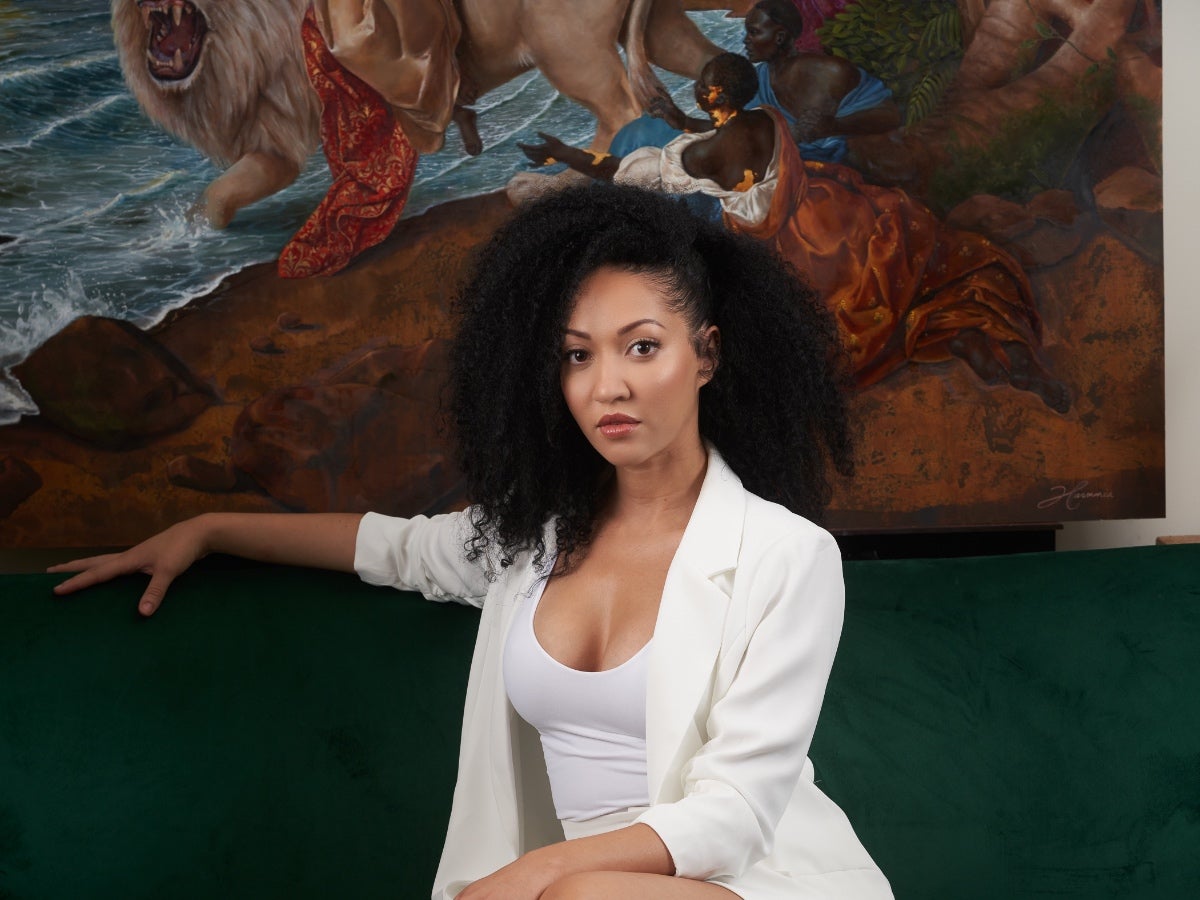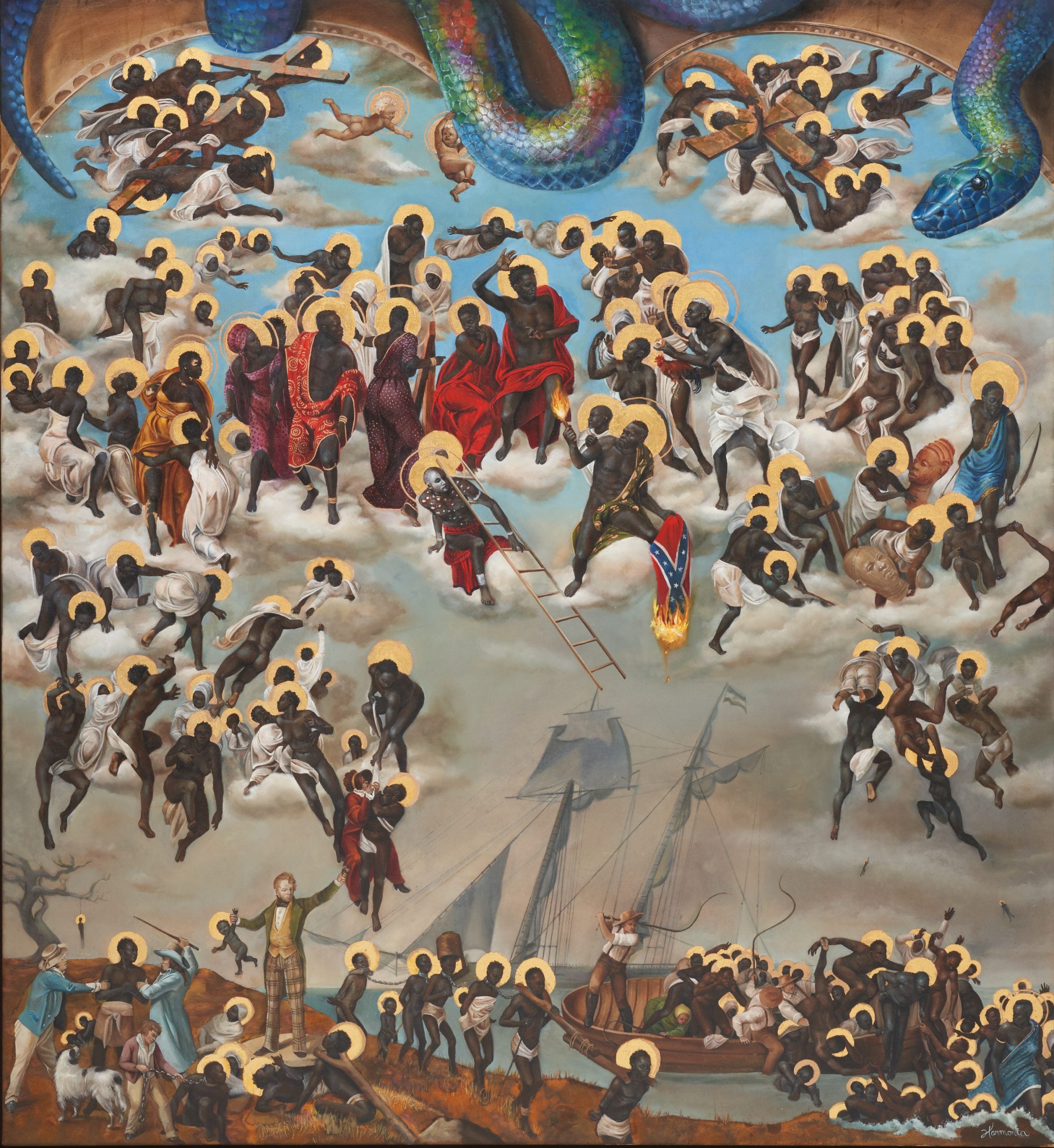 Photo Credit: Elon Schoenfeld
Photo Credit: Elon Schoenfeld On August 18, Afro-Cuban artist Harmonia Rosales opened her Master Narrative exhibition in Atlanta. Held at the iconic Spelman Museum of Fine Art, her work connects the stories and characters of the Yorùbá religion, Greco-Roman mythology, and Christianity with the artistic techniques of the Renaissance era.
Featuring 20 paintings, and a large-scale sculptural installation, this collection of art serves as a challenge to societal norms, as well as the accounts that have been both told and accepted throughout history. From Rosales’ “Forbidden Fruit” painting to the artist’s unique version of Michelangelo’s Sistine Chapel ceiling stretched across the hull of an overturned slave ship, Master Narrative highlights the beauty, strength, and resilience of Black people – women, specifically – while touching upon themes of transcendence, tragedy, survival, and creation.
The Los Angeles-based painter spoke with ESSENCE about her new exhibition, the bridge between religion and her art, why she creates in the style of European Old Masters, and more.
ESSENCE: The wordage Master Narrative, can you tell me what those words mean to you and why did you decide to make it the title for your exhibition?
Harmonia Rosales: Because it’s the all-encompassing narrative. We have used this term throughout my lifetime and continue to use it, although recently we are trying to change the word “master” for other reasons. So this Master Narrative is like the all-encompassing American narrative that has been a very white perspective of history. So, I’m taking that and adding in our perspective. When I say our perspective, it’s everybody from the African diaspora – so the majority – to just have inclusion.
Speaking perspective, what was your initial introduction to Renaissance style paintings and what inspired you to adopt that into your style and how you create?
It goes way back. There’s different approaches on why I use Renaissance. Aesthetically, I fell in love with it as a child. It began there and the reason being is because visiting museums, they looked like huge pages of a children’s book, like illustrations, they told a story. That was my initial introduction to loving Renaissance. The reason why I include or why I paint these “African Gods” in Renaissance techniques is because this particular European aesthetic is tied to a lot of religious works, and Christianity. The African Gods are forever tethered to this Christianity because they were hidden, merged or entwined within these Catholic saints. So what I’m doing now is unmasking them and showing that we have our narratives in these; what we thought were European narratives.
We think that these stories came from Greece and all, but here we have these African Gods, and the stories are quite similar. And then it kind of brings up the question of, well, what came first? Do we know this for a fact? While we don’t know the answer, I would love for us to be included in the conversation.
When I was looking at the catalog for this particular exhibition, the most powerful painting for me was “Still We Rise.” It had themes of religion. Throughout the Bible and even in Western culture, snakes and serpents are symbolic of evil or the devil. But it seemed like in that picture – tell me if I’m wrong – that characters were reaching for the serpent, was that intentional?
Very. Because first you have to really study this religion with a clear mind. So everything is pretty much Christianity, the symbolism in Christianity that symbolizes Satan or the devil is actually strength and knowledge in the Yoruba religion. So, where you have the snake as being seen as a sign of the devil, the snake actually is knowledge, the snake are things that you have to experience in life, good, bad, what have you, in order to reach your destiny. So the shape of the serpent is like the twist and turns and obstacles you face in life. The color of the serpent, which it’s a rainbow serpent, encompasses all the colors. So it means it represents everyone as a community and whole, in order to make any great significant change, we all have to come together. So that is what that serpent is and it’s an actual deity itself.
Then, you have things like the color red and it being demonized, and it also symbolizes sacrifice, but sacrifice is not so much the physical. Yes, it was back then when we were more primitive, but that is all religion if you think about it. It’s more so the sacrifices it took in order to accomplish a goal. For example, our ancestors, what they went through, the sacrifices they went through for us to get to where we’re at, that’s a sacrifice. This is why I represent Eve who encompasses our ancestors in red all the time.
 Still We Rise, 2021. Oil, iron oxide, and gold on canvas.
Still We Rise, 2021. Oil, iron oxide, and gold on canvas.
When you are creating pieces with these specific narratives, is it difficult for you emotionally or are you able to detach from these feelings when you’re creating?
I believe I detach – but my husband could say something else. I’m definitely very moody, so it’s the whole way I carry myself and concentrate. These works touch me on a level where I’m not quite fully aware of, if that makes sense. So as I’m painting [Still We Rise], I might not be as happy as I normally am when I paint other figures or when I paint a scene.
Yemaya, that’s the person you used as Virgin Mary – am I pronouncing it correctly?
Yes, Yemaya.
What went into the decision of you using Yemaya as the Virgin Mary in that particular portrait?
So, when the Atlantic slave trade happened, we were not allowed to practice any of the African Gods. We were supposed to revert solely to Christianity and we didn’t want to give up too much of our identity and so we synchronized our Gods with the Catholic saints. Mary, who is the mother of Jesus, is considered the holy mother, right? That’s Yemaya. Yemaya encompasses the mother, but in this religion there’s no one holy person. “Jesus” is each of us, individually. We each are pretty much the chosen one. Again, I’m masking where she has been hidden for so long, I’m just unmasking her. So it was just natural for me to put her in that Mary position.
There’s also a lot of feminist and Black empowerment themes in your work. Is there a heightened sense of excitement since you’re going to be having this exhibition now at Spelman University, which is such a beacon of black womanhood at all?
Yes, it’s exciting to me, but also anywhere, I believe, it should be something that should be of interest to everyone.
If there were a singular message that you would want viewers to take from this exhibition, what would it be?
An empowerment of self and to open up the question of “why” would be particularly what I want them to walk away with – specifically with religious purposes. I do want to emphasize that the reason why this can synchronize so well with any religion, it’s all-encompassing, Christianity, Muslims, it’s because it is an empowerment of self. It empowers you to question why, when that question does arise, with whatever religion you’re a part of.
TOPICS: black art Spelman CollegeThe post Harmonia Rosales Challenges History’s Perceptions With ‘Master Narrative’ appeared first on Essence.


0 Commentaires